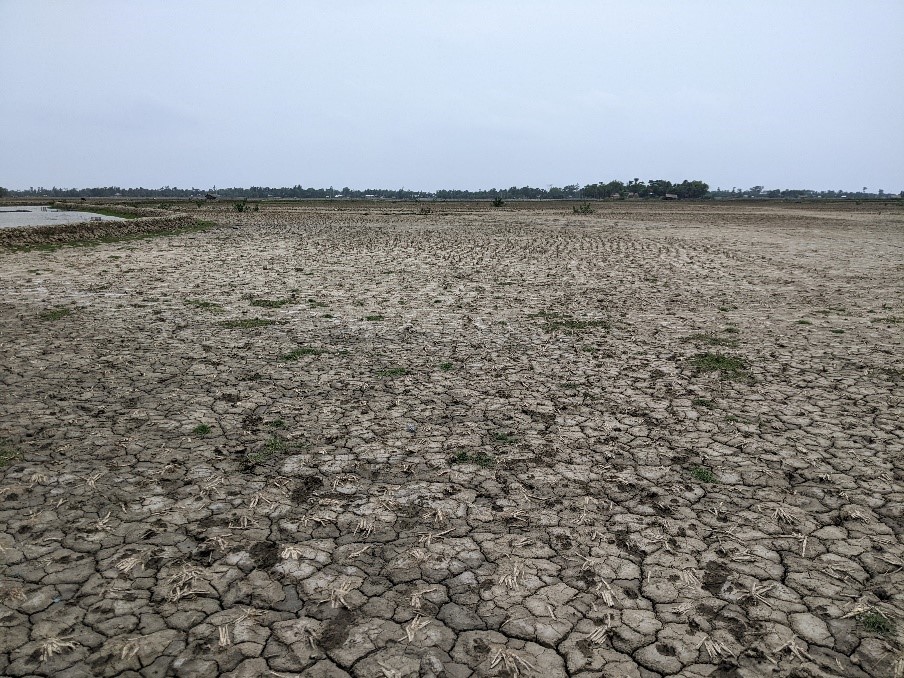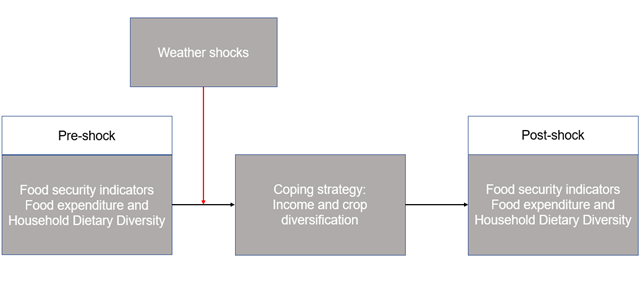IDE Research Columns
Column
Livelihood Diversification Improves Food Security under Climate Change in Bangladesh

Masanori MATSUURA
Institute of Developing Economies, JETRO
October 2023
Extreme weather shocks have occurred frequently owing to global climate change. Weather shocks deteriorate household welfare, such as poverty, food security, and health. Farmers often diversify their crops or incomes to cope with weather shocks. We find that weather shocks induce livelihood diversification. Moreover, livelihood diversification can improve household food security, but its effect is small, especially for poor households, implying that poor households have limited capacity to benefit from livelihood diversification.
Climate Change Adaptation to Build Resilient Household Food Security
Extreme weather events have occurred frequently because of global climate change. Smallholder farmers are particularly vulnerable to weather shocks owing to their high dependence on agriculture for their livelihood, chronic food insecurity, physical isolation, and lack of access to formal safety nets (Chuang 2019). Bangladesh is one of the most vulnerable countries to climate variability, and the agrarian sector represents 38% of the total Bangladeshi employment (ILO 2021). Adapting to intense weather shocks is deemed imperative to sustain farmers’ livelihoods and food security in developing countries.
Livelihood diversification is referred to as the process by which rural families construct a diverse portfolio of activities, including diversifying income sources and crops that they bring up (Ellis 1998). Livelihood diversification is one of the most important characteristics of rural livelihoods. Furthermore, the diversification may improve dietary quality through subsistence- and income-generating pathways. Therefore, diversification in its various forms is an important strategy for improving food and nutritional outcomes in low- and middle-income countries (Jones 2017).
We explicitly assess the impact of livelihood diversification on dietary diversity and food expenditure in Bangladesh. By doing so, the important policy implications regarding the effects of livelihood diversification can be inferred from our study.
Conceptual Framework and Data
The conceptual framework in our study examines how Bangladeshi rural households develop livelihood diversification against weather shocks to improve household food security. We hypothesize that weather shocks worsen household food security and Bangladeshi households have the incentive to diversify their crops and income sources to make themselves highly resilient to weather shocks. Figure 1 depicts our conceptual framework and indicates that weather shocks are expected to be drivers of income and crop diversification. Then, the livelihood diversification would prevent household food security from being worsened by the weather shocks.
We use the Bangladesh Integrated Household Survey (BIHS) conducted by the International Food Policy Research Institute and monthly precipitation and temperature data from the Bangladesh Meteorology Department in 2011/2012, 2015, and 2018/2019 to conduct empirical analysis based on the conceptual framework. BIHS is the newest and nationally representative panel household survey in Bangladesh. Taking advantage of BIHS and the weather data, we can give comprehensive insights into climate change adaptation in Bangladesh.

Figure 1. Conceptual Framework of Weather Shocks, Livelihood Diversification, and Household Food Security
Source: Created by the author based on Matsuura et al. (2023).
Improvement of Household Food Security by Livelihood Diversification
First, we find that past drought shocks in dry seasons significantly decrease crop diversification, whereas the negative temperature shock in rainy seasons increases crop and income diversification. Hence, households adapt to weather shocks through livelihood diversification. We also find that the usage of irrigation and access to infrastructures, such as paved roads, are significant determinants of livelihood diversification. Furthermore, farm households obtaining information concerning new agricultural products and adaptive strategies through agricultural extension services are likely to diversify, either in terms of crop or income diversification.
Second, we find that crop diversification increases food expenditure. Income diversification increases household dietary diversity score1, including food expenditure. The results are as expected because income diversification not only improves food availability but also reduces poverty through off-farm employment.
Finally, we find that wealthier households benefit more from income diversification than poorer ones. This result is consistent with past studies, such as Barrett, Reardon, and Webb (2001). According to Barrett, Reardon, and Webb (2001), fewer benefits of remunerative income diversification received by households cause barriers. The poor, unskilled, and uneducated from remote areas are likely to participate in nonfarm employment. Moreover, poor households do not have enough access to financial systems to provide sufficient working capital. Another barrier is that the rural poor are incapable of access to market opportunities.
Policy Implications
First, our results indicate that the income diversification strategy is an effective coping strategy on average for rural households in Bangladesh. Therefore, income diversification should be promoted and considered a strategy for reversing the trend of food insecurity. Second, the heterogeneous impact of the livelihood diversification strategies helps identify policy options that are greatly tailored to the needs of the socioeconomically diverse rural population in Bangladesh.
Policy-relevant determinants of households’ livelihood diversification identified in this study are access to irrigation, usage of agricultural extension services, and sufficient infrastructures. Access to irrigation helps farm households to increase crop diversification to improve food consumption. Additionally, we suggest that additional extension services should be considered when designing programs to effectively assist farmers in coping with climate change. Further access to agricultural extension services would enable farmers to access information on livelihood diversification and farming practices for sustainable production. Moreover, building infrastructure would be effective for household food security because it generates great access to nonfarm work opportunities. Our findings highlight that livelihood diversification is important for preparing for climate change and that poor farmers’ capacity for livelihood diversification is severely limited, calling for urgent policy support.
Author’s Note:
This column is based on Matsuura, Masanori, Yir-Hueih Luh, and Abu Hayat Md. Saiful Islam. 2023. “Weather Shocks, Livelihood Diversification, and Household Food Security: Empirical Evidence from Rural Bangladesh.” Agricultural Economics 54 (4): 455–70. https://doi.org/10.1111/agec.12776
Note:
- Household dietary diversity score is calculated by summing the number of food groups per household over a 7-day recall period. The 12 food groups are “cereals,” “white tubers and roots,” “vegetables,” “fruits,” “meat,” “eggs,” “fish and other seafood,” “legumes, nuts, and seeds,” “milk and milk products,” “oils and fats,” “sweets,” and “spices, condiments, and beverages” (Kennedy et al. 2007).
References
Barrett, Christopher, Thomas Reardon, and Patrick Webb. 2001. “Nonfarm Income Diversification and Household Livelihood Strategies in Rural Africa: Concepts, Dynamics, and Policy Implications.” Food Policy 26(4): 315–31. https://doi.org/10.1016/S0306-9192(01)00014-8
Chuang, Yating. 2019. “Climate Variability, Rainfall Shocks, and Farmers’ Income Diversification in India.” Economics Letters 174: 55–61. https://doi.org/10.1016/j.econlet.2018.10.015
Ellis, Frank. 1998. “Household Strategies and Rural Livelihood Diversification.” Journal of Development Studies 35 (1): 1–38. https://doi.org/10.1080/00220389808422553
ILO (International Labour Organization). “ILO Modelled Estimates Database” ILOSTAT. Accessed January 2021. https://ilostat.ilo.org/data
Jones, Andrew D. 2017. “Critical Review of the Emerging Research Evidence on Agricultural Biodiversity, Diet Diversity, and Nutritional Status in Low-and Middle-income Countries.” Nutrition Reviews 75 (10): 769–82. https://doi.org/10.1093/nutrit/nux040
Kennedy, Gina L., Pedro Maria Regina, Seghieri Chiara, Nantel Guy, and Brouwer Inge. 2007. “Dietary Diversity Score Is a Useful Indicator of Micronutrient Intake in Non-Breast-Feeding Filipino Children.” Journal of Nutrition 137 (2): 472–77.
Author’s Profile

Masanori Matsuura is a research fellow at Institute of Developing Economies (MSc in Agricultural Economics). His research interests lie in agricultural, development, and environmental economics. His work has been published in Agricultural Economics.
Other Articles by This Author
Matsuura, Masanori, Obed Chanda, Chieko Umetsu, Wataru Kodama, and Abu Hayat Md. Saiful Islam. 2023. “Gender Matters in Farm Investment: Implications for Land Tenure and Household Welfare” IDE Discussion Paper no.902. https://dx.doi.org/10.2139/ssrn.4458717
Matsuura, Masanori, Abu Hayat Md. Saiful, and Salauddin Tauseef. 2023. “Mobile Phone Ownership, Income Diversification, and Household Welfare in Rural Bangladesh” IDE Discussion Paper no.875. http://doi.org/10.20561/00053562
*The views expressed in the columns are those of the author(s) and do not represent the views of IDE or the institutions with which the authors are affiliated.
**Thumbnail image: Photo by the Author (Bangladesh, June 2023)

